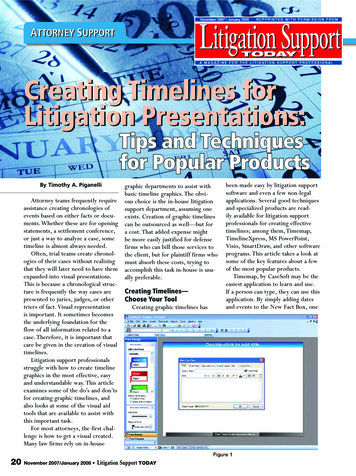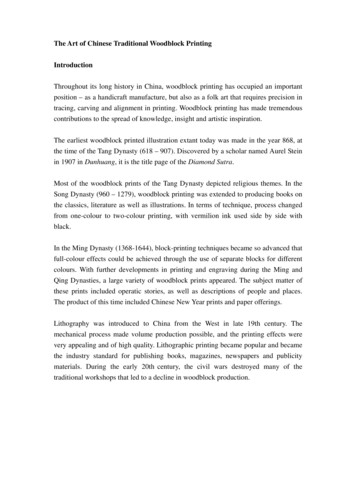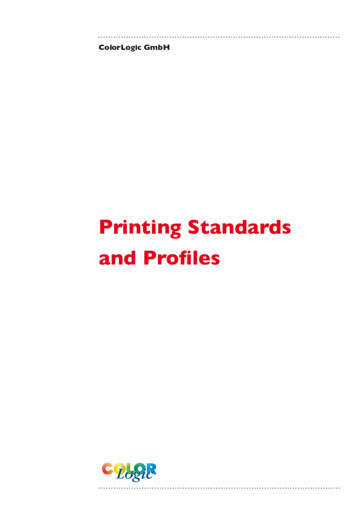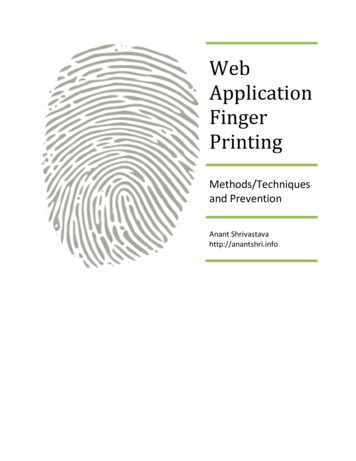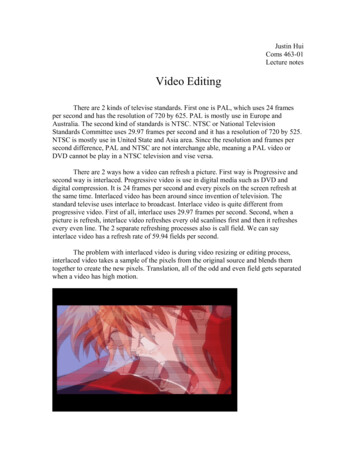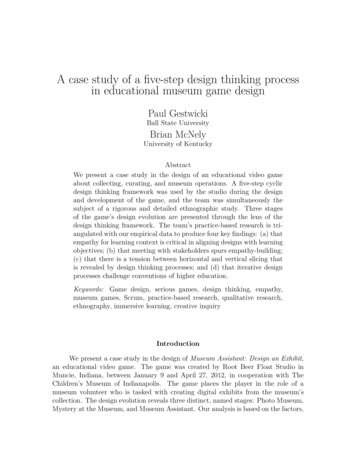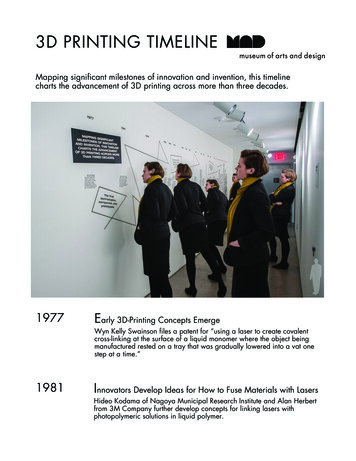
Transcription
3D PRINTING TIMELINEMapping significant milestones of innovation and invention, this timelinecharts the advancement of 3D printing across more than three decades.1977Early 3D-Printing Concepts EmergeWyn Kelly Swainson files a patent for “using a laser to create covalentcross-linking at the surface of a liquid monomer where the object beingmanufactured rested on a tray that was gradually lowered into a vat onestep at a time.”1981Innovators Develop Ideas for How to Fuse Materials with LasersHideo Kodama of Nagoya Municipal Research Institute and Alan Herbertfrom 3M Company further develop concepts for linking lasers withphotopolymeric solutions in liquid polymer.
1986Chuck Hull Patents Stereolithography and Founds 3D Systems,Inc.Chuck Hull is granted a patent for “Apparatus for Production of ThreeDimensional Objects of Stereolithography,” the first commercial rapidprototyping technology, also known as additive manufacturing or 3Dprinting. Hull also develops the STL file format, which allows 3D digitalfiles to be converted into 3D-printed objects.Carl R. Deckard Patents Selective Laser Sintering (SLS)TechnologyCarl R. Deckard files a patent for Selective Laser Sintering, a project hebegan researching as an undergraduate at the University of Texas atAustin. The first SLS machine, nicknamed Betsy, fuses small particles ofplastic, metal, ceramic or glass powders into solid 3D forms with a highpowered laser.1989The First Known Artist Works with 3D-Printing TechnologiesMasaki Fujihata uses stereolithography to create his computer-generatedwork, Forbidden Fruits, a golden orange, semi-translucent group oforganic forms arranged in a sculptural cluster.S. Scott Crump Patents Fused Deposition Modeling (FDM):FDM, a 3D-printing technology, applies materials in a series of additivelayers by mathematically slicing and orienting models. Crump alsoestablishes Stratasys, a 3D printing and production company.Drs. Hans J. Langer and Hans Steinbichler Found EOS GmbHElectro Optical Systems:Drs. Langer and Steinbichler found EOS in Germany. They use 3D printingwith Selective Laser Sintering (SLS) technology generated by data fromCAD software.1990Wilifried Vancraen Founds Materialise, the First RapidPrototyping Service Bureau:Vancraen establishes Materialise in Belgium, concentrating on theresearch and development of solutions for the transfer of data to 3Dprinters.1991Helisys Creates Laminated Object Manufacturing (LOM):LOM prints in 3D by using paper that is unrolled and glued layer by layer.
Cubital Ltd Introduces Solid Ground Curing (SGC):This technology flashes layers of printing materials with ultraviolet (UV)light to harden polymers through a series of masks created by electrostatictoner on a plate.1993First Worldwide Computer Sculpture Exhibition:Ars Mathematica, based in France, organizes the first exhibition devotedto computer sculpture at the Ecole Polytechnique in Paris; this exhibitionlater evolves into the “Intersculpt” biennial.Soligen Commercializes Direct Shell Production Casting:The company bases its technology on the Massachusetts Institute ofTechnology’s patent for ink jetting a liquid binder onto ceramic powder toform shells that are then used in the casting process.1994Solidscape Incorporates and Introduces First 3D Wax PrintingSolidscape produces high-precision 3D printers, materials and softwarefor the direct manufacturing of solid objects designed in CAD. Thecompany creates the first 3D wax printer, ModelMaker.1995Z Corporation Introduces Z Printers:Z Corporation, commonly called Z Corp, produces Z Printers, which actlike inkjet printers in that a head moves across a bed of powder,selectively depositing a liquid binding material in the shape of the section.The printer then spreads a fresh layer of powder across the top of themodel and the process is repeated.1997Materialise Introduces Next-Day 3D Printing Service:The 24-hour service, Materialise NextDay, allows customers to order 3Dprinted objects online.AeroMat Launches 3D Metal Printer:AeroMat, a subsidiary of MTS Systems Corp., produces the first 3Dprinted metal using Laser Additive Manufacturing (LAM), which employshigh-powered lasers to fuse powdered titanium alloys.
1999Objet Geometries Is Founded and Introduces 3D-PrintedObjects That Can Simulate Different Material Properties in OneObjectSpecializing in high-resolution rapid prototyping and rapid manufacturing,Objet Geometries Ltd. produces the first 3D printer that can print bothhard and soft materials, and a range of hardnesses in between, that look,feel and function like the final product.Voxeljet Is Founded:The company’s goal is to develop new generative processes for castingand producing plastic components using 3D printing. Voxeljet focuses onlarge-scale production, making the molds for several automotivecompanies’ engines.Scientists Create the First 3D-Printed Organ:Scientists at the Wake Forrest Institute for Regenerative Medicine createthe first 3D-printed lab-grown organ, a bladder. The bladder is made froma patient’s own cells, significantly reducing the risk for rejection ifimplanted. (Note: This organ was not implanted; for the first working 3Dprinted organ, see 2003.)2000Mammoth Stereolithography Machine Allows for Large-ScalePrinting:Materialise launches the Mammoth Stereolithography machine, which hasa build area of more than two meters. This enables the large-scalecreation of 3D objects in one piece through the successive addition ofliquid polymer hardened using a laser beam.2002Fast, High-Quality 3D Objects Become AvailableEnvisiontec starts manufacturing their Perfactory Machine (first unveiled in2001) that allows for the production of exceptionally large 3D parts atfast speeds without sacrificing surface quality and part accuracy. Themachine eliminates the look of visible line layers and has a build volumeof 500 x 600 x 400mm (20 x 24 x 16 inches).2003Arcam Launches the First Commercial Electron Beam Melting(EBM) SystemThis system melts metal powder together, layer by layer, using an electronbeam in a high-temperature vacuum.
Other Important DevelopmentsEOS introduces the first laser-sintered, metal-based powder machine.Z Corp introduces the world’s first commercially available multiple-color3D printer.The first 3D-printed working organ, a kidney, is created in China.2005First Fully Articulated 3D-Printed Furniture CreatedFrench artist Patrick Jouin creates the C1 chair, which is built as a cellularstructure superimposed onto a standard chair form.The same year, Materialise produces the first 3D-printed stool that isprinted in one piece, complete with concealed hinges.First At-Home 3D Printers EmergeThe RepRap project, founded by Dr. Adrian Bowyer at the University ofBath, brings the world the first at-home 3D printer.2006Multi-Material 3D Printer Available to the PublicThe Fab@Home project, one of the first open-source DIY printing projects,brings multi-material printing to the public that is low-cost and “hackable.”3D-Printed Cobalt Chrome and Stainless SteelThe first laser-sintered 3D Printer, EOSINT M 270 by EOS, prints cobaltchrome and stainless steel.2007Objet Upgrades 3D Printers to Include 14 Varieties ofHardness That Simulate Different Material Properties in OneObjectObjet introduces the Connex series of 3D printers that enable users tocombine two different materials in one print job in a variety ofcombinations that produce up to fourteen different levels of hardness,texture and shading, with no assembly, creating forms that range fromrigid to rubber, dense to hollow and translucent to opaque.2008New Matrix System Enables 3D Printing with Regular Sheets ofPaperMcor Technologies, founded by Dr. Conor MacCormack and FintanMacCormack, launches the New Matrix system that adheres A4 sheets ofpaper together using Helisys LOM technology.
RepRap Project Releases Darwin, the First Open-Sourced 3DPrinter HardwareThis spawns a huge 3D-printing maker community worldwide.Shapeways Starts its Online 3D Printing ServiceShapeways launches in the Netherlands as a spin-off of Royal PhilipsElectronics. Using this online 3D printing service, individuals can use asimplified design process made for consumers to make, buy and sell theirown products that are then inexpensively printed and delivered.First Usable Prosthetic CreatedThe first usable prosthetic with all its parts, including knee, foot, andsocket, is printed in one piece without any assembly required. Thisdevelopment leads to the creation of Bespoke Innovations, Inc. in 2010.User-Created Open-Source Design FlourishesThingiverse launches a website dedicated to sharing user-generated digitaldesign files, providing primarily open-source hardware design licensesunder the GNU General Public License (a Creative Commons License).2009Laika Animation Makes First 3D-Printed Animated MovieLaika animation studio uses 3D printing to make the “puppets” (i.e., theanimated characters) for Coraline. The heads and hands are 3D printed,then painted by hand.3D Printing Gets its First Standard Reference GuideSeventy individuals from around the world meet at the ASTM InternationalHeadquarters near Philadelphia, PA, to establish ASTM Committee F42 onAdditive Manufacturing Technologies. This results in the publication of thefirst standard terminology reference.MakerBot Industries Makes 3D Printing More Accessible forIndividualsMakerBot Industries is founded with an open-sourcing model, offeringproducts that are created not with the intent to mass-produce, but ratherfor individuals. Printers are sold as do-it-yourself kits, requiring only minorsoldering.2010The Centre for Fine Print Research Is the First to 3D PrintPorcelainBased out of England, the Centre patents their system for 3D printingporcelain using the ZCorp 310 Printer.
Scott Summit and Kenneth Trauner Found Bespoke Innovations,Inc.:The company creates personalized 3D-printed prosthetics.Other Important DevelopmentsHP signs an agreement with Stratasys and becomes the first largeconsumer electronics company to manufacture 3D printers.Freshfiber is first company worldwide to exclusively use 3D printing tocreate consumer products.MGX, by Materialise, opens the first store exclusively for 3D-printedgoods in Brussels.Continuum Fashion and Shapeways create n12, the first ready-to-wear,3D-printed and fully articulated bikini.2011First 3D-Printed Animated Movie in All ColorLaika animation studio and Aardman Animations both produce 3Dprinted “puppets” in full color for ParaNorman and The Pirates! Band ofMisfits, respectively.Fused Deposition Modeling (FDM) Patent ExpiresThe expiration of the FDM patent brings technology and information intothe public domain that is a catalyst for creativity and open sourcing,building on the momentum created by RepRap and other open-sourcingcompanies.President Barack Obama Announces AdvancedManufacturing Process Partnership (AMP)This national initiative, bringing together industry, universities and thefederal government to invest in emerging technologies, aims to increaseU.S. competitiveness in manufacturing.3D-Printed Dress “One of 50 Best Inventions”TIME Magazine names Iris van Herpen’s first-ever 3D-printed flexibledress as one of the 50 Best Inventions of the year.First 3D-Printed Precious MetalSterling silver is 3D printed for the first time by Cookson Precious Metals.First 3D-Printed AircraftDesigned at the University of Southampton, the first 3D-printed aircraft iscreated in just seven days.
First 3D-Printed VehiclesHAWK University of Applied Sciences and Arts, Germany, teams withStratasys to create the world’s first one-person vehicle with a bionic formmodeled after a human jaw. The Rapid Racer took 10 days, included3,600 layers and was made from a 44 MB file.Stratasys and Kor Ecologic Inc. co-develop the Urbee hybrid, the world’sfirst production car ever to have its entire body, including its glass-panelprototypes, 3D printed.The European Aeronautic Defence and Space (EADS) group in Englandcreates the first 3D-printed bicycle, the Airbike, out of nylon that is asstrong as steel or aluminum, but only 65% of the weight.“Desert Manufactured” 3D Printing Uses the World’s MostEfficient and Abundant Energy Source, the Sun:Raising questions about the future of manufacturing, Markus Kaysercreates the Solar Sinter in the Sahara desert. This machine uses twoabundant resources, silica sand and the sun, to harness the sun’s energyinto creating 3D-printed objects made of glass (melted and cooled silicasand).2012First 3D-Printed JawLayerWise builds the world’s first 3D-printed jaw implant for an 83-yearold patient in the Netherlands. The implant helps promote the growth ofnew bone tissue.3D-Printed Affordable Housing Appears on the HorizonDr. Behrokh Khoshnevis at the University of Southern California creates anautomated construction technology, Contour Crafting, that has thepotential to build an entire housing unit in one day for a quarter of thecosts of manual construction methods. This technology also reducesenvironmental impact by creating less waste and emission pollution.First 3D-Printed GunThe “Liberator” pistol is created by Cody Wilson, a Texas law student.Wilson shares his blueprints for making the gun on the Internet, causing acontroversy and leads to Wilson being dubbed one of the “15 MostDangerous People in the World” by Wired Magazine.3D-Printed Candy and GoldFirst 3D chocolate printer, the Choc Creator, is made commerciallyavailable.Gold is 3D printed for the first time by Cookson Precious Metals.
Stratasys Creates 3D-Printed “Magic Arms”These arms, fully articulated with custom-molded parts, give a two-year-oldchild the use of her limbs.3D Precision Engineering Meets FootwearA Selective Laser Sintering (SLS)-crafted cleat is the first 3D-printed shoeplate designed for high-performance football athletes. Through proprietarymaterial selection, Nike was able to prototype a fully functional plate andtraction system at a fraction of the time and weight of traditionalmanufacturing techniques.2013Planning 3D-Printed Lunar Habitations of the FutureFoster and Partners, along with several smaller firms, teams with theEuropean Space Agency (ESA) to develop a lunar habitation using 3Dprinted parts transported by rockets, as well as 3D-printed materials usingthe moon’s own soil. Destined for the moon’s south pole, the structureswould protect inhabitants from meteorites, gamma radiation andtemperature fluctuations.3D Printing Saves LivesBaby’s life is saved with a groundbreaking 3D-printed splint created at theUniversity of Michigan. The splint, made of biological material, opened upthe child’s lungs and allowed him to breathe freely.NASA Embraces 3D PrintingNASA announces a plan to explore the possibility of 3D printing food inspace for astronauts. At the same time, the organization announces thedevelopment of a 3D printer, to be launched in 2014, which can maketools on demand, reducing the need to bring unnecessary supplies intospace. NASA also successfully tests the first 3D-printed rocket fuel injector.Timeline compiled by the Education Department at the Museum of Arts and Designwith special assistance from Stephan Hoskins, Centre for Fine Print Research,and Vanessa Palsenbarg, Materialise.
The first 3D-printed working organ, a kidney, is created in China. First Fully Articulated 3D-Printed Furniture Created French artist Patrick Jouin creates the C1 chair, which is built as a cellular structure superimposed onto a standard chair form. The same year, Materialise produces the first 3D-printed stool that isFile Size: 1MB
